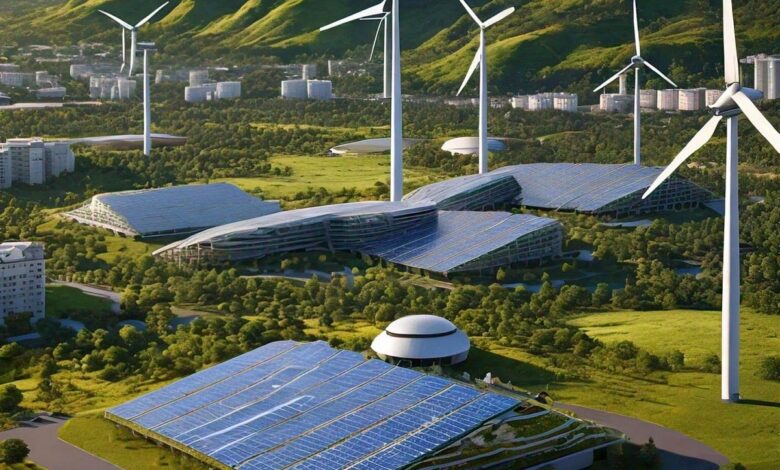RENEWABLE ENERGY MANAGEMENT WITH INCREASING PRODUCTIVITY DUE TO ROBOTIC TECHNOLOGIES | by Gokulnath N | Jun, 2024

“Robotics is the future of renewable energy maintenance, enhancing productivity while significantly reducing maintenance costs through innovative and efficient solutions.”
RENEWABLE ENERGY MANAGEMENT WITH INCREASING PRODUCTIVITY BECAUSE OF ROBOTIC TECHNOLOGIES
Introduction
In today’s rapidly advancing technological landscape, the intersection of ROBOTICS and RENEWABLE ENERGY is revolutionizing how we manage and optimize energy production. Robotic technologies are not only enhancing productivity but also significantly reducing maintenance costs. This article explores the integration of robotics in various renewable energy modes and highlights the best energy storage systems, supported by real-world examples and cutting-edge innovations.
Solar energy harnesses power from the sun using photovoltaic cells. Robotic technologies in solar energy include automated cleaning systems, precision installation robots, and maintenance drones.
Example: The Helios 3D system by RoboSolar installs panels with high accuracy, and Ecoppia’s robotic cleaners maintain efficiency without water.
Wind energy converts wind flow into electricity using turbines. Robotics enhance this sector through automated inspection and maintenance drones.
Example: Skyspecs’ drones perform detailed turbine inspections, identifying defects and reducing downtime.
Hydroelectric energy generates power from flowing water. Underwater robots are used for inspecting and maintaining turbines and other underwater structures.
Example: The RIMCAW robot by Hydrovision inspects and maintains underwater turbines without requiring shutdowns.
Biomass energy converts organic materials into electricity. Automated systems sort and process biomass efficiently, reducing labor and waste.
Example: The ZenRobotics Recycler uses AI-driven arms to sort biomass, optimizing the energy production process.
Geothermal energy taps into the Earth’s internal heat. Robotics are used to automate drilling and maintenance tasks, enhancing efficiency.
Example: Baker Hughes employs robotic drilling systems to access geothermal resources with precision and safety.
Ocean energy harnesses power from waves and tides. Robotic technologies play a role in the installation, maintenance, and monitoring of underwater energy devices.
Example: Carnegie Clean Energy’s CETO system uses robots for deploying and maintaining wave energy converters.
Hydrogen energy involves producing hydrogen fuel through electrolysis. Robotics automate the production, storage, and distribution processes.
Example: H2Pro’s E-TAC technology uses robots to enhance the efficiency of hydrogen production and distribution.
Solar thermal energy uses sunlight to generate thermal energy for electricity or heating. Automated systems control the positioning and cleaning of mirrors or collectors.
Example: BrightSource Energy employs robotic systems to maintain optimal mirror alignment and cleanliness in solar thermal plants.
Floating solar farms are solar panels installed on bodies of water. Robots are used for installation, maintenance, and cleaning, ensuring efficiency and minimizing human labor.
Example:Ciel & Terre’s Hydrelio system uses robotic platforms to install and maintain floating solar panels.
Lithium-ion batteries are widely used due to their high energy density and efficiency. They are crucial for storing energy from intermittent renewable sources.
Example: Tesla’s Powerwall** provides reliable home energy storage, integrating with solar panels and the grid.
Pumped hydro storage uses gravity to store and release energy by moving water between reservoirs at different elevations.
Example: The Dinorwig Power Station in the UK uses this method to provide quick-response energy storage.
CAES stores energy by compressing air and releasing it to generate electricity when needed.
Example: The Huntorf plant in Germany is one of the world’s first and most efficient CAES systems.
Flow batteries store energy in liquid electrolytes, offering scalability and long cycle life.
Example: Redflow’s ZBM2 flow battery provides robust energy storage for commercial and industrial applications.
Thermal energy storage involves storing heat energy for later use, often in molten salts.
Example: Abengoa Solar’s Solana plant uses molten salt to store solar thermal energy, allowing for electricity generation even after sunset.
In California, NextEra Energy has developed autonomous solar farms where robotic systems handle installation, maintenance, and optimization. These systems use AI and robotics to maximize energy capture and ensure efficient operations.
In the North Sea, Ørsted employs autonomous drones and underwater robots for offshore wind farm maintenance. These robots perform regular inspections, reducing human intervention and operational risks.
At Switzerland’s Grande Dixence Dam, underwater robots inspect and maintain the hydroelectric plant’s infrastructure, ensuring efficiency and reducing the need for human divers.
Denmark’s Måbjerg Bioenergy Plant utilizes automated sorting and processing robots to handle agricultural waste, increasing efficiency and reducing operational costs.
Baker Hughes uses robotic drilling systems to access geothermal resources, enhancing precision and safety in geothermal energy extraction.
While robotics in renewable energy management offers numerous benefits, it also raises ethical considerations such as job displacement and environmental impact. Sustainable practices must be developed to balance technological advancements with ethical responsibility.
To mitigate environmental impact, companies are exploring eco-friendly materials and recycling for robotic components. **ABB Robotics** is researching ways to create robots with minimal carbon footprints.
Apple’s Recycling Program Apple Inc. runs a highly efficient recycling program called Apple Renew. They use robots like Liam and Daisy to disassemble iPhones and recover valuable materials such as cobalt and lithium. This not only reduces electronic waste but also ensures that rare materials are reused rather than mined anew, promoting sustainability.
Coca-Cola’s World Without Waste Initiative Coca-Cola has committed to collecting and recycling a bottle or can for every one it sells by 2030. The company has invested in designing packaging that uses less material and is easier to recycle, and has partnered with local organizations to improve recycling infrastructure globally.
Patagonia’s Worn Wear Program Patagonia encourages customers to buy used products through its Worn Wear program, which includes repairing and reselling old gear. This initiative reduces waste and promotes a circular economy, where products are reused rather than discarded.
While robotics can displace certain jobs, it also creates new opportunities in robot maintenance, programming, and oversight. Training programs are essential to equip the workforce with the skills needed in a technologically advanced landscape.
Amazon’s Warehouse Robotics: Amazon uses thousands of robots in its warehouses to move goods and assist with packaging. However, the company also employs a significant number of human workers to handle tasks that require more nuanced judgment and dexterity. This balance allows for increased efficiency while still providing jobs to people.
Tesla’s Manufacturing Plants Tesla’s Gigafactories are equipped with advanced robotics for the assembly of electric vehicles and batteries. Despite the high level of automation, Tesla still employs many human workers for quality control, software development, and other complex tasks that robots cannot perform.
UPS’s Use of AI and Human Workers UPS employs AI and robotics for sorting and logistics to streamline operations and improve efficiency. However, they also rely on human drivers for deliveries, ensuring that jobs are preserved while leveraging the benefits of automation.
Conclusion
The integration of robotics in renewable energy management is a game-changer, driving productivity and sustainability in unprecedented ways. As we continue to innovate, the future of renewable energy looks promising, with robotic technologies at the forefront.
“Embracing robotics in renewable energy not only boosts productivity but also paves the way for a sustainable, cost-efficient future.”


